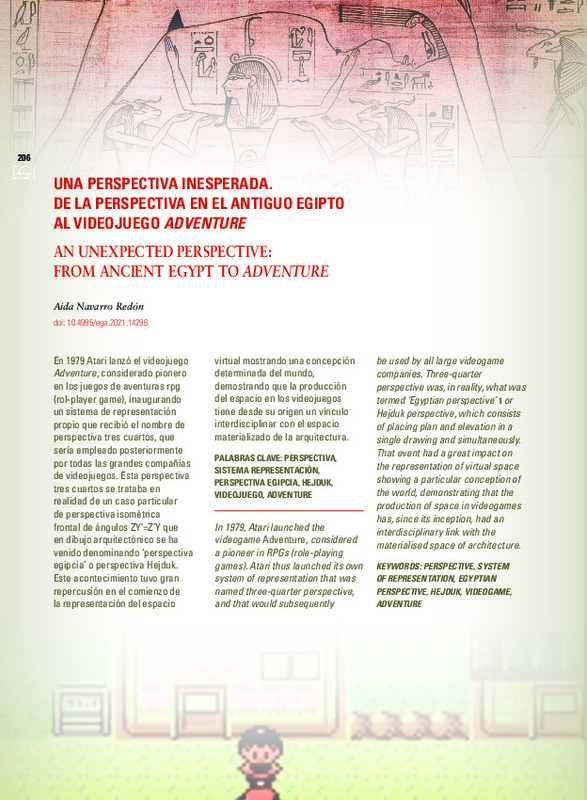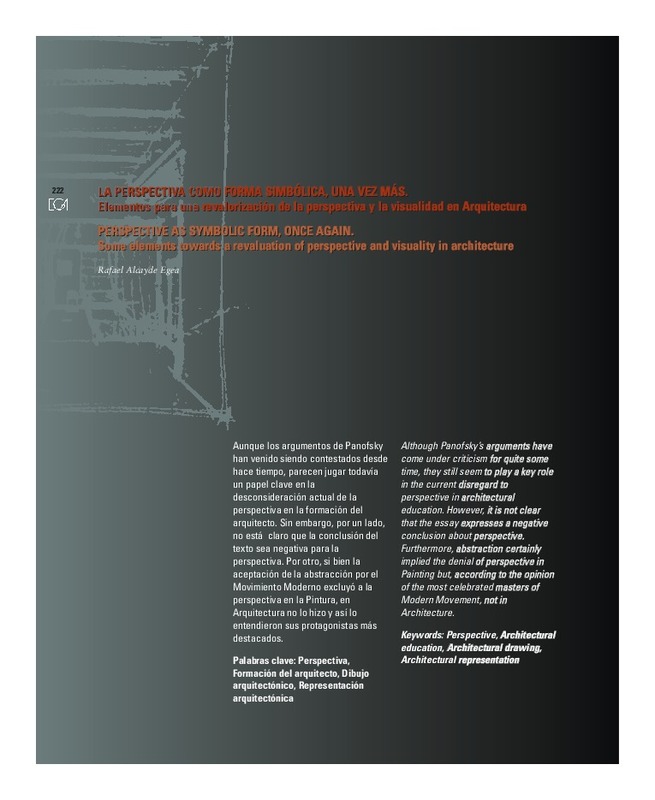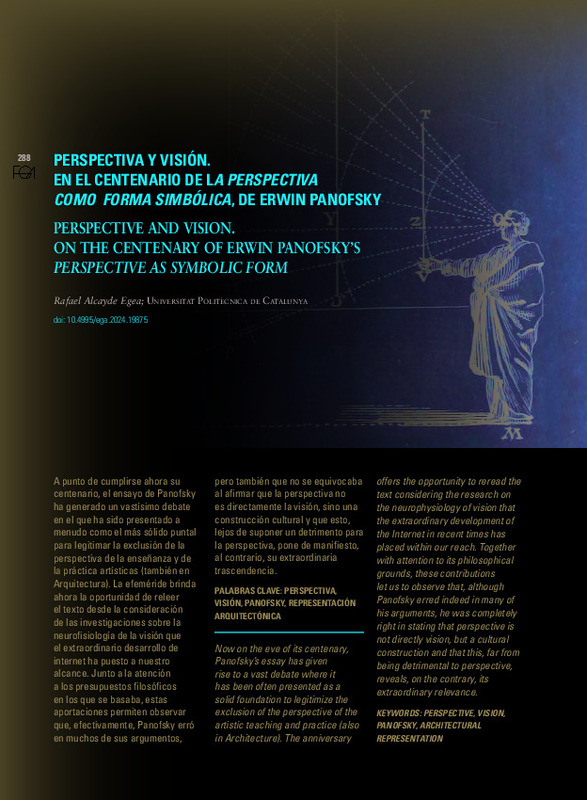JavaScript is disabled for your browser. Some features of this site may not work without it.
Buscar en RiuNet
Listar
Mi cuenta
Estadísticas
Ayuda RiuNet
Admin. UPV
Una perspectiva inesperada. De la perspectiva en el antiguo Egipto al videojuego Adventure
Mostrar el registro sencillo del ítem
Ficheros en el ítem
| dc.contributor.author | Redon, Aida Navarro
|
es_ES |
| dc.date.accessioned | 2021-03-30T07:17:54Z | |
| dc.date.available | 2021-03-30T07:17:54Z | |
| dc.date.issued | 2021-03-24 | |
| dc.identifier.issn | 1133-6137 | |
| dc.identifier.uri | http://hdl.handle.net/10251/164574 | |
| dc.description.abstract | [ES] En 1979 Atari lanzó el videojuego Adventure, considerado pionero en los juegos de aventuras rpg (rol-player game), inaugurando un sistema de representación propio que recibió el nombre de perspectiva tres cuartos, que sería empleado posteriormente por todas las grandes compañías de videojuegos. Esta perspectiva tres cuartos se trataba en realidad de un caso particular de perspectiva isométrica frontal de ángulos ZY’=Z’Y que en dibujo arquitectónico se ha venido denominando ‘perspectiva egipcia’ o perspectiva Hejduk. Este acontecimiento tuvo gran repercusión en el comienzo de la representación del espacio virtual mostrando una concepción determinada del mundo, demostrando que la producción del espacio en los videojuegos tiene desde su origen un vínculo interdisciplinar con el espacio materializado de la arquitectura. | es_ES |
| dc.description.abstract | [EN] In 1979, Atari launched the videogame Adventure, considered a pioneer in RPGs (role-playing games). Atari thus launched its own system of representation that was named three-quarter perspective, and that would subsequently be used by all large videogame companies. Three-quarter perspective was, in reality, what was termed ‘Egyptian perspective’ 1 orHejduk perspective, which consists of placing plan and elevation in a single drawing and simultaneously. That event had a great impact on the representation of virtual space showing a particular conception of the world, demonstrating that the production of space in videogames has, since its inception, had an interdisciplinary link with the materialised space of architecture. | es_ES |
| dc.description.sponsorship | Grupo de Investigación Hypermedia, Warren Robinett, Rice University. | es_ES |
| dc.language | Español | es_ES |
| dc.language | Inglés | es_ES |
| dc.publisher | Universitat Politècnica de València | es_ES |
| dc.relation.ispartof | EGA Expresión Gráfica Arquitectónica | es_ES |
| dc.rights | Reconocimiento - No comercial - Sin obra derivada (by-nc-nd) | es_ES |
| dc.subject | John Hejduk | es_ES |
| dc.subject | Perspectiva Hejduk | es_ES |
| dc.subject | Sistema de representación | es_ES |
| dc.subject | Perspectiva | es_ES |
| dc.subject | Perspectiva egipcia | es_ES |
| dc.subject | Videojuego | es_ES |
| dc.subject | Adventure | es_ES |
| dc.subject | Perspective | es_ES |
| dc.subject | System of representation | es_ES |
| dc.subject | Egyptian perspective | es_ES |
| dc.subject | Videogame | es_ES |
| dc.subject | Hejduk perspective | es_ES |
| dc.title | Una perspectiva inesperada. De la perspectiva en el antiguo Egipto al videojuego Adventure | es_ES |
| dc.title.alternative | An Unexpected Perspective: from Ancient Egypt to Adventure | es_ES |
| dc.type | Artículo | es_ES |
| dc.identifier.doi | 10.4995/ega.2021.14296 | |
| dc.rights.accessRights | Abierto | es_ES |
| dc.description.bibliographicCitation | Redon, AN. (2021). Una perspectiva inesperada. De la perspectiva en el antiguo Egipto al videojuego Adventure. EGA Expresión Gráfica Arquitectónica. 26(41):206-217. https://doi.org/10.4995/ega.2021.14296 | es_ES |
| dc.description.accrualMethod | OJS | es_ES |
| dc.relation.publisherversion | https://doi.org/10.4995/ega.2021.14296 | es_ES |
| dc.description.upvformatpinicio | 206 | es_ES |
| dc.description.upvformatpfin | 217 | es_ES |
| dc.type.version | info:eu-repo/semantics/publishedVersion | es_ES |
| dc.description.volume | 26 | es_ES |
| dc.description.issue | 41 | es_ES |
| dc.identifier.eissn | 2254-6103 | |
| dc.relation.pasarela | OJS\14296 | es_ES |
| dc.description.references | ARES, Ignacio. La organización del espacio en perspectiva egipcia. Revista de Arqueología nº191p 30-37 (March 1997). | es_ES |
| dc.description.references | BAROLSKY, Paul. The playful artifice of douanier Rousseau's persona. Source: Notes in the History of Art 13, no. 1 21-25 (Fall 1993). https://doi.org/10.1086/sou.13.1.23203036 | es_ES |
| dc.description.references | BARTON, Matt. Dungeons and Desktops: The History of Computer Role-Playing Games. A K Peters/CRC Press (2008). https://doi.org/10.1201/b10638 | es_ES |
| dc.description.references | DELEUZE, Gilles. El fin del espacio egipcio y el molde geométrico-cristalino. Pintura. El concepto de diagrama. Ed Cactus. Buenos Aires (2008) | es_ES |
| dc.description.references | DONOVAN, Tristan. Replay: la historia de los videojuegos. Ed. Héroes de papel. (2010) 2018 6.Gentil Baldrich, J. María. Sobre la supuesta perspectiva antigua (y algunas consecuencias modernas). Ed. Universidad de Sevilla. Sevilla. (2012) | es_ES |
| dc.description.references | GOMBRICH, E.H. La historia del Arte. Ed. Phaidon. London (1950) 1999 | es_ES |
| dc.description.references | HEJDUK, John. Mask of Medusa. Works 1947-1983. Rizzoli International Publications. (1989) 9.Heydenreich, L H. Leonardo da Vinci. Enciclopedia Universale dell'arte. Vol VIII Istituto per la collaborazione culturale, Pages 562-590 Venezia - Roma (1958) | es_ES |
| dc.description.references | IZQUIERDO ASENSI, Fernando. Geometría descriptiva superior y aplicada, Madrid, s.n., 2000, 24ª ed. | es_ES |
| dc.description.references | KENT, Steven. L. The Ultimate history of videogames. Penguin Random House Group Ed. España. (2001) 2016 | es_ES |
| dc.description.references | LUQUE, Andrés. Picasso, documentos sobre la ascendencia del arte egipcio en el personaje central de las señoritas de Aviñón. Laboratorio de Arte. Núm.17, Universidad de Sevilla, Pages 523-534. Sevilla. (2005) | es_ES |
| dc.description.references | PARKINSON, Richard. Painted Tomb Chapel of Nebamun. Ed. Brisith Museum Press. London (2008) | es_ES |
| dc.description.references | PERRON, Bernard. WOLF, Marl J.P. The Video Game Theory Reader. Routledge. London (2003) | es_ES |
| dc.description.references | PERROT, Georges. CHIPIEZ, Charles Histoire de l'art dans l'antiquité: Egypte, Assyrie, Perse, Asie Mineure, Grèce, Étrurie, Rome (Band 1): L'Egypte. Paris. (1903) (accessed on September 15, 2018 at https://digi.ub.uni-heidelberg.de/diglit/perrot1882bd1) | es_ES |
| dc.description.references | RABASA DIAZ, Enrique. Proyección y representación: conceptos intuitivos. Colección Cuadernos del Instituto Juan de Herrera, Madrid, 2000. | es_ES |
| dc.description.references | RAE. Direccionario de la Real Academia de la Lengua Española. Espasa Ed. (2017) | es_ES |
| dc.description.references | REMIE, C. O. Chess and Courtly Culture in Medieval Castile: The Libro de ajedrez of Alfonso X, el Sabio, περ. Speculum, A Journal of Medieval Studies, Vol 2. Page 82 (2007) 19. https://doi.org/10.1017/S0038713400009404 | es_ES |
| dc.description.references | ROBINETT, Warren. Interview for Stanford University. https://web.stanford. edu/dept/HPS/TimLenoir/ MilitaryEntertainment/Atari/Warren%20Robinett%20 Interview.html (1997) (accessed on September 13, 2018) | es_ES |
| dc.description.references | ROBINETT, Warren. GDC Talk on Adventure (2015) (accessed on September 14, 2018) 21.Robinett, Warren. Personal interview via email on September 14, 2018 | es_ES |
| dc.description.references | RUBIN, William. La génesis de Les demoiselles d'Avignon; at Les demoiselles d'Avignon. pages 374- 375. Paris (1987) Barcelona (1988) | es_ES |
| dc.description.references | SÁNCHEZ GALLEGO, Juan Antonio. Geometría descriptiva. Sistemas de proyección cilíndrica, Barcelona, UPC, 1998. | es_ES |











